Oral language, Print knowledge
Children will be familiar with the author Eric Carle, including how some experiences in Eric Carle’s childhood helped him write books for children.


New:
[Display one Eric Carle book previously read with children in your room.]
This is a book we have read before. Does anyone remember the title of this book or what the book is about? (different responses based on book selected)
The author of this book is Eric Carle. This week we will find out how Eric Carle writes and illustrates books.
 [Display picture of Eric Carle.]
[Display picture of Eric Carle.]
This is a picture of Eric Carle. When he was a young boy, he enjoyed being creative using art materials like paint and paper.
Eric Carle also liked to take walks with his father and learn about nature when he was young. Nature is everything in the world that is not made by people.
When he went walking with his dad, he saw bugs and caterpillars and trees and clouds. He learned to love nature on these walks.
Do you like to do any of the things Mr. Carle did as a child? If yes: What do you like to do?
When Mr. Carle got to be a grown-up, he started to write books for children. He remembered the walks outdoors that he took with his father when he was a boy. Mr. Carle decided to write about things in nature, like animals and insects.
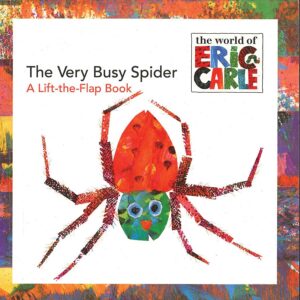 Some of the information in Mr. Carle’s books is true. Something that is true is called a fact. Other information in Mr. Carle’s books is made up. Some of the people or the things that happen in the story are not real. Something that is made up is called fiction.
Some of the information in Mr. Carle’s books is true. Something that is true is called a fact. Other information in Mr. Carle’s books is made up. Some of the people or the things that happen in the story are not real. Something that is made up is called fiction.
Let’s read The Very Busy Spider. Let’s think about things in the book that are about nature.
Let’s also think about the things in the book that are true and the things that have been made up.
[Read The Very Busy Spider.]
What parts of this book are about nature? (the sun, animals)
The spider in this story spins a web. Real spiders spin webs. This is a fact.
In Mr. Carle’s book the animals talk to each other.
Do real animals talk to each other with words that people use? (no)
The idea that animals talk to each other using people words is made up. Remember, something that is made up is called fiction.
This week we will read some books by Eric Carle. We will also write our own classroom story.
Today we learned that Eric Carle was creative with art materials and took nature walks with his father when he was a boy. These experiences helped him write books for children when he became an adult.
Extra support
Enrichment
Add Eric Carle books to your library center for children to look at and read with friends. Provide flannel board pieces for children to retell a story.
Have an Eric Carle “show and tell.” Encourage children to search the book collection at their home or at the library, and to bring their favorite Eric Carle story to share with friends.
Geometric and spatial knowledge
Children will strengthen their understanding that basic shapes can be different sizes.

For Option 2:

For Option 2:
Review:
Size
Offer Week 10, Day 2 to review different sizes of basic shapes.
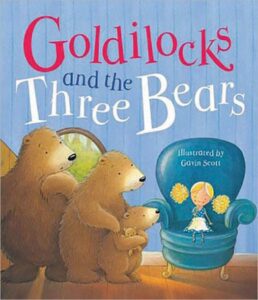 Engage children in noticing the size of the bears’ items in a story and in sorting shapes by size.
Engage children in noticing the size of the bears’ items in a story and in sorting shapes by size.
Introduce the book. Explain that the book will help us remember that shapes come in different sizes. Remind children that size means how big something is.
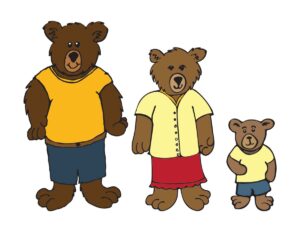 As you read the book, pause to note the shape and size of the bears’ bowls, chairs, and beds. Example: “I see three bowls. What shape are the bowls? Are the bowls the same size?”
As you read the book, pause to note the shape and size of the bears’ bowls, chairs, and beds. Example: “I see three bowls. What shape are the bowls? Are the bowls the same size?”
After reading the book, describe and tape bear cutouts in a line at the top of a chart paper. Explain that we will help each of the bears get items in the correct size.
Display the three circle cutouts. Invite children to pretend the circles are the bears’ bowls. Draw attention to the different sizes of circles. Ask children which bear should get which size of bowl. Invite volunteer children to tape each circle under its corresponding bear.
Display the three square cutouts. Invite children to pretend the squares are the bears’ chairs. Repeat the process described above.
Repeat the process described above with the rectangles. Invite children to pretend the rectangles are the bears’ beds.
Executive function
Children will remember and carry out actions in response to aural and oral prompts.

None

Review:
Practice
Be Prepared: If time permits, offer Drum Beats from Week 36, Day 2 as a second game. If the game described below is too challenging for a majority of children, stop at an appropriate place and offer Drum Beats from Week 36, Day 2. The game for today may be less challenging when offered again at a later point.
Today we will play a game we’ve played before called It’s Raining, It’s Pouring. Remember, we will use our hands and voices for this game.
How do we play It’s Raining, It’s Pouring?
We will make different noises for our pretend rainstorm. Before we make a new rainstorm, let’s practice the sounds and actions we’ve done before. Remember, when we practice something, we do it many times so we can get better at it.
[As you demonstrate each sound, and the action that produces the sound, invite children to imitate you. Practice each sound for several seconds before moving to the next one.]
Let’s make a new rainstorm together.
Now we will make a rainstorm with different sounds. Watch and listen carefully as I show you the new movements and sounds.
[As you demonstrate each sound and the action that produces the sound, invite children to imitate you. Practice each sound for several seconds before moving to the next one. Omit one of the sounds if you anticipate four consecutive sounds will be too challenging for children.]
Now let’s make a new rainstorm together.
[Repeat the sequence if time permits and children remain appropriately engaged.]
Today we practiced listening carefully so we would know what to do. We also practiced remembering what to do.
In our game we made the different sounds of a rainstorm. We listened carefully when we practiced making each sound. We also listened carefully for the name of the sound we were to make.
Extra support
Enrichment
Encourage children to continue to make the various sounds of a rainstorm. Guide children in playing It’s Raining, It’s Pouring by giving them cues, if necessary. Children may wish to focus on one or two of the sounds.
Help children gain a better understanding of rainstorms by reading books about rainstorms. As children listen to the books, encourage them to repeat sounds they may hear in the books. Examples: Tap Tap Boom Boom by Elizabeth Bluemle and Thunder Boomer by Shutta Crum.
Knowledge of earth and space
Children will use four of their five senses to explore characteristics of soil. They also will understand that soil is a natural and essential resource.


New:
Natural resource
Review:
Be Prepared: Use provided pictures to prepare a chart similar to one shown in activity plan. Today’s activity involves children smelling and touching soil. Adapt the activity to accommodate the policy of your classroom or center regarding children’s contact with soil. Fill five quart-size plastic bags with soil. You may wish to use soil that includes some small pebbles, rocks, a partially decomposed leaf, and/or pieces of a root. Five bags are recommended to facilitate sharing.
This week we will talk about something that many people love to play and work in. We will talk about dirt!
Do you know another word for dirt? (soil)
Remember, soil is the dirt we see on the ground.
Where can we find soil? (playground, yard, garden, farm field, etc.)
We are going to use four of our five senses to learn more about soil. We will not use our sense of taste. We should never taste soil because it might make us sick.
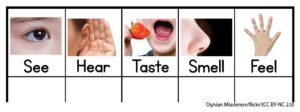 [Display prepared chart. Point to parts of the chart as you describe each. Repeat each word as you write it on the chart.]
[Display prepared chart. Point to parts of the chart as you describe each. Repeat each word as you write it on the chart.]
I will record on this chart what we learn about soil. Our chart has one section for each of the five senses: see, hear, taste, smell, feel.
I will put an X under the word “taste” on our chart to remind us that we should never taste soil.
The first section of our chart focuses on our sense of sight. We use our eyes for our sense of sight. The word on our chart says “see.” We use our eyes to see things around us. Let’s use our eyes to take a look at our soil.
[Pass around five bags of soil. Write children’s descriptions on the chart under the corresponding sense.]
Let’s review what we learned about soil.
[Point to and read your entries on the chart.]
Soil is a natural resource. A natural resource is something found in nature that can be used by people. We know that nature is everything in the world that is not made by people. Some other natural resources are water and trees.
Soil helps people in many ways. Soil helps plants grow. Plants provide food for people and other animals. This is one of the big ways soil is helpful to people.
What else do plants need in order to grow? (water, sunlight, air, nutrients)
Plants get water from the rain or snow that falls to the ground. The soil in the ground holds the water. Plants use water held in the soil to make their food.
What part of a plant is found in the soil? (roots)
Today we used four of our five senses to describe soil. We used a chart to record what we learned. Soil is a natural resource. A natural resource is found in nature and is very important to people. Soil helps plants to grow. How are plants helpful to people and other animals? (provide food)
Extra support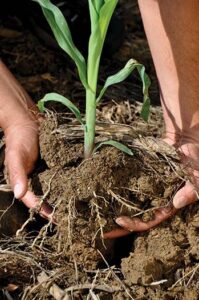
Enrichment
Fill the sensory table or a tub with potting soil. Provide cups, bowls, spoons, magnifying glasses, and other items for exploration. Remind children not to taste the soil. You may wish for children to wear gloves to keep their hands clean.
If weather permits, take children to an outdoor space where they can explore soil by looking. Provide magnifying glasses for children to get a closer look at soil.